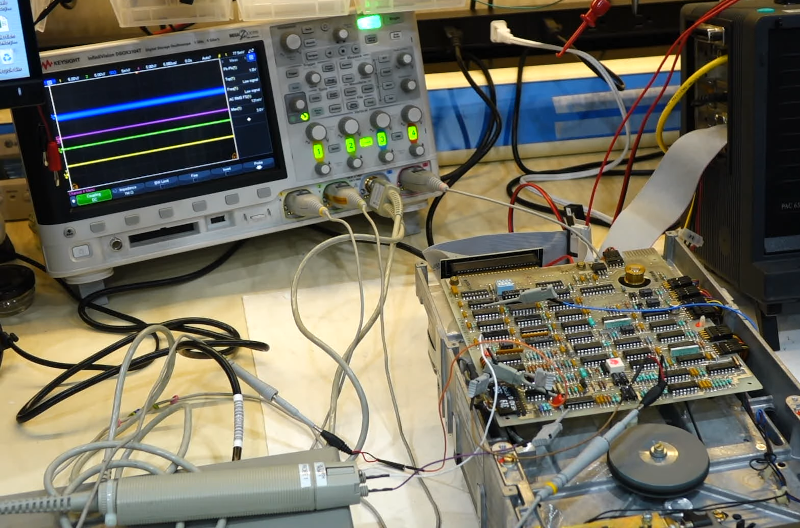[CuriousMarc] has a pile of 8-inch drives, all marked bad. You can’t just pop over to the computer store and buy a new one these days, so it was off to the repair bench. Although the target drive would do a quick seek, once it was in use, it just kind of shut down. So [Marc] started sending low-level commands to the device to see if he could isolate the fault. You can watch the whole adventure in the video below.
Using a breakout board, he was able to monitor and exercise all the pins going into the floppy. A quick study of the schematics, and connection to the scope were all [Marc] needed to build some theories of what was happening.
One of the theories was that the head amplifier was disabled, but it turned out to be fine. After several other dead ends, he finally found a broken spring and came up with a creative repair for it. But there was still no clear reason why the drive wouldn’t work. By process of elimination, he started to suspect an array of diodes used for switching, but again, it was another dead end.
Luckily, he had one working drive, so he could compare things between them. He found a strange voltage difference. Turns out the old advice of checking power first might have paid off here. One of the voltage regulator ICs was dead. In all fairness, there are two 12V power supplies and he had checked one of them but had missed the second supply. This supply is only used for head bias which switches the diodes he had suspected earlier. There had also been a loose pin that might have been a contributor.
With a new power supply IC, the drive worked but needed an alignment. You may never need to repair an 8-inch floppy drive, but the logic in chasing down a problem like this will serve you well on any diagnostic task.
If you think the big drives won’t work with a modern PC, they will. On the other hand, if you need to read some badly enough, you could just use an oscilloscope.
















Interesting ….
I used to work in a repair shop where, amongst other things, we used to see a routine flow of 8″ floppy drives. The biggest things for fixing were read head realignment and replacement drive heads – both jobs took about 14 hrs on the bench, including bedding-in and soak teasing. The head alignment took about 2 hrs with an alignment disk and an oscilloscope.
Board repairs always began with new voltage regulators (cheap as chips) and occasionally new smoothing capacitors. The first time the regulators were replaced on any board also needed brass ferrules to be crimped and soldered to replace the through-hole plating.
All three of us in that workshop were ecstatic when those 8″ drives were finally withdrawn from service in the late 1980s.
…drive?
We no longer use floppies in our computers. All we have is hard and solid.
8″ format.. That was my father’s times. He had Turbo Pascal on 8″ floppy! Or was it a flappy ?!
CP/M used an 8″ diskette format, originally, as well.
If memory serves, this was the only official format it knew without modification.
Other disk formats like Osborne etc. became soon popular, but the original CP/M was made with 8″ in mind.
Using it on 5,25″ or 3,5″ and 3″ disks was still possible, but not efficient.
It was also the format that was supported as the RX01 drive on DEC PDP systems – formatted single-sided with 1024 sectors of 127 bytes per sector (yup – 127kB disks).
The interface carried the identical signals to the later 5¼” drives, but the timings and pin-out were different.
I used to have the complete RT-11 development suite on 8″ floppies (that included the source code for the OS). I think it was 28 floppies in all.
Later versions of CP/M were optimised for the larger capacity, faster 5¼” drives and eventually, fixed drives.
> Off topic
– When I click on the YouTube video link in this story in Edge or Chrome it says ‘ http://www.youtube.com is blocked’ http://www.youtube.com refused to connect. Works in Firefox though. Is this just me? Can’t think of what would cause this – nothing has changed on my end AFAIK.
It’s not just you, I’m seeing the same thing in Chrome as well. Link appears to be correct in the post, will have to look into this a bit.
Same error 6 months later. No fix anywehere. Chrome version 118.0.5993.118
After having seen the AGC reverse engineering video series and recently the laboratory setup of the communication modules of the Apollo missions, watching him repair a floppy drive makes me feel like we are killing a mosquito with a cannon…